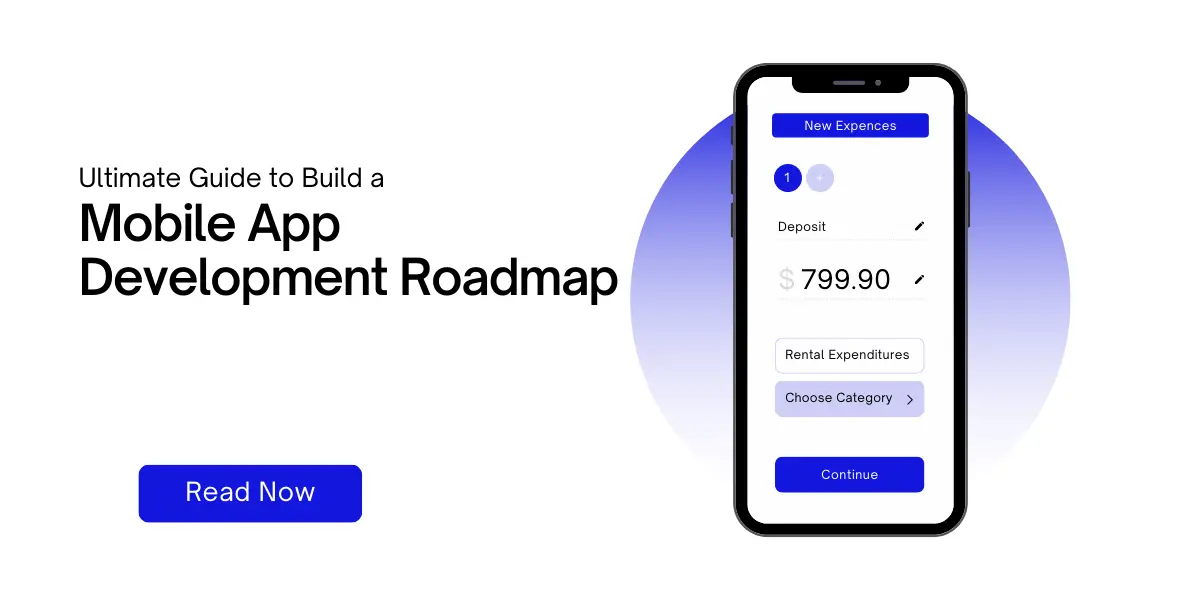Mobile app development isn’t the same for every niche or objective. You need to build an app development roadmap that creates an interactive base for your app. Now this roadmap offers an outline of the activities and goals. This acts as the reference for the complete team for the app development. If you want to know how it helps, let’s dive in to know more.
What is a mobile app development roadmap?
A mobile app development roadmap is a strategic tool. As, it describes an app’s objectives, activities, and dates. It appears as a horizontal bar graph and provides a clear overview of daily activities, progress updates, and future goals. This visual document is critical to the software development lifecycle (SDLC). Also, it acts as a reference for developers, product managers, and stakeholders. This versatility guarantees that teams can adjust to changing consumer needs.
Why is an app development roadmap important?
Here are some reasons to get the development roadmap.
- Team clarity: Developers receive insight into how their work fits into larger corporate goals. And it allows them to prioritize jobs.
- Stakeholder collaboration: Roadmaps enables product managers to showcase feature priorities. So, the investors achieve consensus on product direction.
- Strategic vision: Non-technical teams like marketing and sales, can quickly understand project objectives. Or you can get a mobile app development company for more assistance.
- Enhanced communication: Cross-functional teams may track updates and changes. It identifies potential hazards early on and keeps work on track.
Steps to build a mobile app development roadmap
Here is the step-by-step guide to building a complete journey.
Define your vision
Begin by asking yourself why you’re creating the application. And you must know how your business will flourish with these goals. Your product vision should address crucial questions such as:
- What problem does the app solve?
- Who is the intended audience?
- What are the business objectives?
- Why is now the appropriate time to launch?
This basic phase guarantees that you are creating something valuable. And it lays the groundwork for setting an app development roadmap and initiatives.
Set clear goals
Goals are measurable, time-bound objectives that help steer your team. Such as, “Achieve 10,000 downloads within six months” is a specific aim. However, initiatives are broad areas of focus, such as improving user experience.
Mapping features to these efforts allows for better progress tracking. It also ensures that each activity contributes to the overall vision. This systematic strategy helps teams stay motivated and engaged.
Know your audience
Executives should focus on high-level goals to be consistent with corporate objectives. Marketing teams should highlight features and their potential to increase user engagement. You can include release dates in the app development roadmap to help in pitching. It even provides technical information, task deadlines, and dependencies. Creating audience-specific roadmaps ensures that everyone has the necessary information.
Prioritize the features
Not all features are created equally. Use approaches such as user story mapping to prioritize the ones that provide the most value. A user narrative map visually depicts how users interact with your program. Even it assists in identifying critical features and those that may be deferred to future upgrades. This method prevents scope, keeps development focused, and guarantees user expectations.
Create flexible timelines
Instead of setting strict deadlines, consider employing quarterly or monthly timelines. This technique allows for unforeseen delays and market changes. While keeping a controlled procedure in the process.
For example, Gantt charts can be quite useful for visualizing dependencies and scheduling work. By outlining each phase, teams can anticipate potential bottlenecks and stay on pace.
Choose mapping tools
A good app development roadmap tool facilitates collaboration and visualization. While Excel was originally the go-to tool and newer cloud-based alternatives. Such as Jira, Trello, and Asana provide better flexibility and accessibility.
When choosing a tool, check the ease, customization choices, and team compatibility. The proper tool may speed up updates and serve as a single source of truth.
Conclusion:
A mobile app development roadmap is a strategy for success. You can design a tool that aligns your team, satisfies stakeholders, and adds value to your vision. Even if you’re creating your first app a well-structured roadmap will help you navigate the difficulties. Or you get a mobile app development company for more assistance.
For Latest Update – Kyalu
Also Read
- ► Swastik Legal: Best Advocate in Surajpur, Best Advocate in Surajpur Court, and Best Advocate in Greater Noida
- ► Top 5 Features to Look for in an AI Landing Page Builder
- ► Why Eoan Technologies is the Best SEO Agency in Gurgaon for Your Business Growth
- ► Navigating Class 9: A Transitional Year for Students with Maths Classes for Class 9
- ► Can a Legal Heir Certificate Be Used for Property Transfer? Explained
- ► Best Web Development Institute in Delhi
- ► Master Financial Modeling for Career Success: Your Ultimate Guide to Courses and Certifications
- ► Unlock the Value of Your Precious Silver: A Comprehensive Guide to Cash for Silver
- ► From Runway to Real Life: Sp5der Hoodies Looks
- ► Why Bangalore Students Should Pursue a MBA in Germany
- ► Digital Games Market Size, Share & Trends 2025-2034
- ► Top Benefits of High Pressure Calibration for Safety and Precision
- ► Multi Asset Allocation Fund A Fantastic Way for Your Wealth
- ► How to Get abroad Student Loan Without Collateral in Indore?
- ► Latest CAFM System and EAM Software Solutions for 2025





